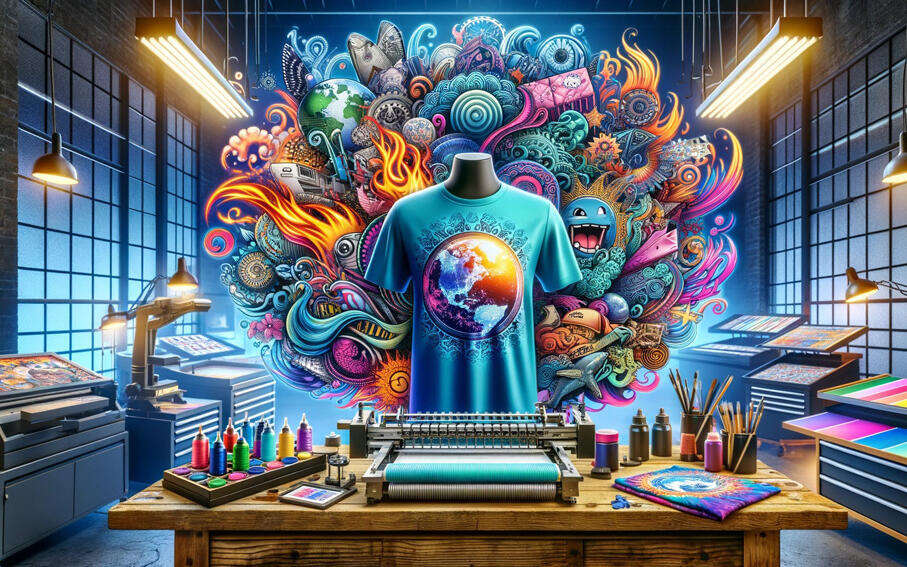Hey there, design enthusiasts and savvy entrepreneurs! Welcome to another insightful blog post from Time for Designs, your hub of creativity, collaboration, and innovation. Today, we're diving deep into a topic that's close to our hearts and wallets—how to monetize your design skills.
In a world brimming with possibilities, design has emerged as more than just an art form; it's a lucrative career path and a vital aspect of any successful business. Whether you're a freelancer looking to level up your game, or a business aiming for that impactful brand presence, this post is your go-to guide.
We get it; the design world can be overwhelming. With so many avenues like Sublimation, Large Format Printing, Digital Print, and even Print on Clothing, where do you even start? Right here, that's where!
So, grab a cup of coffee, or tea if that's your jam, and let's get this show on the road. Ready to turn your creative prowess into a money-making machine? Let's get started, shall we?
The Evolution of Design
Ever wondered how we got from simple sketches on paper to the digital marvels we see today? Well, buckle up because we're about to take a trip down design history lane.
More Than Just Aesthetics
First off, let's debunk a common myth: design is not just about making things look pretty. Sure, aesthetics play a role, but design is a multi-faceted discipline that marries creativity, strategy, and problem-solving. It's about creating experiences, evoking emotions, and most importantly, fulfilling a purpose.
The Humble Beginnings: Graphic Illustrations
Remember the days when graphic design was all about posters, logos, and brochures? Those were simpler times. Graphic design laid the foundation for visual communication, but it was just the tip of the iceberg.
The Digital Revolution: Web Design & UX/UI
Enter the digital age, and suddenly, design took on a whole new dimension—literally. Web design became the new frontier, and it wasn't long before UX/UI (User Experience/User Interface) design followed suit. These fields focus on enhancing user interaction and experience, making them indispensable in today's digital landscape.
Beyond the Screen: Digital Print & Large Format Printing
But wait, there's more! The design industry didn't just stop at screens; it expanded into the physical world. Digital print technology revolutionized traditional printing methods, offering higher quality and quicker turnaround times. And let's not forget large format printing, which has given us everything from eye-catching billboards to stunning art installations.
The Fabric of Creativity: Print on Clothing
And just when you thought design couldn't get any more versatile, it made its way onto fabrics. Print on clothing has opened up a new realm of possibilities, from custom t-shirts to intricate fashion designs. It's not just about what you see; it's about what you wear.
The Sky's the Limit: The Future of Design
So, what's next for design? With advancements in technology like augmented reality, virtual reality, and AI, the possibilities are virtually limitless. And the best part? Each of these avenues offers unique opportunities to monetize your skills.
The Bottom Line
The design industry has come a long way, evolving from mere graphic illustrations to a vast landscape that includes web design, UX/UI, digital print, and even print on clothing. The scope is limitless, and so are the opportunities to make money. So whether you're a seasoned designer or a newbie looking to break into the industry, there's a slice of the pie for everyone.
The Freelancer's Paradise
Hey freelancers, this one's for you! If you're looking to turn your design skills into a profitable venture, you've come to the right place. Let's break down the three pillars of freelancing success: Portfolio Building, Networking, and Pricing Strategy.
Portfolio Building: Your Digital Business Card
The Importance of a Portfolio
First things first, you need a killer portfolio. Think of it as your business card in the digital age. It's the first impression you'll make on potential clients, so you better make it count.
What to Include
Showcase your best works, whether it's sublimation, large format printing, or ingenious web designs. Include case studies, testimonials, and even the process behind your projects. This adds depth and shows you're not just about the end result but also about how you get there.
Brand Consistency
Make sure your portfolio resonates with your brand colours and ethos. For us at Time for Designs, that's a vibrant blend of yellow and pink! Your portfolio should be an extension of your brand, a visual representation of who you are and what you bring to the table.
Networking: Your Gateway to Opportunities
The Power of Connections
Don't underestimate the power of a strong network. In the freelance world, who you know can sometimes be as important as what you know.
Where to Network
Attend industry events, webinars, and online forums. These are gold mines for meeting potential clients and fellow designers. And hey, in the age of social media, your next big project could be just a DM away.
Building Relationships
Networking isn't just about collecting business cards; it's about building relationships. Offer value, be genuine, and the opportunities will follow.
Pricing Strategy: The Art of Making Money
Market Research
Deciding how much to charge can be tricky. Start by researching market rates for the kind of work you do. Websites like Glassdoor and freelance job boards can give you a ballpark figure.
Your Unique Value
But don't just stick to the market rates. Consider the unique value you bring to the table. Are you particularly fast without compromising on quality? Do you offer a unique style that's hard to find? Factor these into your pricing.
Quality Over Everything
Always prioritize quality; it's the cornerstone of long-term success. Clients are more likely to pay a premium for work that stands out and exceeds expectations. So, don't cut corners, and don't undervalue your skills.
Businesses, Listen Up!
Hey business owners and decision-makers, this section is tailor-made for you! In a world where consumer attention spans are shorter than ever, how do you make your brand unforgettable? Let's delve into the key aspects: Branding, In-House vs. Outsourcing, and the ROI on Design.
Branding is Key: Your Business Identity
The Importance of Branding
In today's competitive market, branding is more important than ever. It's not just about having a product or service; it's about creating an identity that resonates with your target audience.
The Role of Design in Branding
A well-designed logo or website can set you apart from the crowd. These are not just visual elements; they're the face of your brand. They communicate your business values, your ethos, and your unique selling proposition.
Invest in Professional Design Services
Don't cut corners when it comes to your brand. Invest in professional design services to make a lasting impact. Whether it's a logo, website, or even your business cards, quality design can elevate your brand and attract more customers.
In-House vs. Outsourcing: The Eternal Debate
The Pros and Cons
Should you hire an in-house team or outsource? Both have their pros and cons. In-house teams offer better collaboration and a deeper understanding of your brand. Outsourcing, on the other hand, can be cost-effective and offer a fresh perspective.
Evaluate Your Needs
Consider your project's complexity, timeline, and budget. If you have ongoing, complex design needs, an in-house team might be beneficial. For one-off projects or specialized skills, outsourcing could be the way to go.
Make an Informed Decision
Don't rush into a decision. Evaluate your needs, weigh the pros and cons, and make an informed choice. Remember, the right team can make or break your design project.
ROI on Design: More Than Just Numbers
Design as an Investment
Design is not an expense; it's an investment. According to various studies, companies that invest in good design see a significant increase in brand engagement and sales.
You Can read More Here Unlocking the ROI of Good Design: a Data-Backed Guide to Strategic Design Investment
Quality Over Quantity
Don't skimp on quality. A well-designed website or marketing collateral can have a higher ROI than you might think. It's not just about aesthetics; good design can improve functionality, user experience, and ultimately, customer satisfaction.
The Bottom Line
Investing in quality design services can offer a tangible return on investment. Whether it's increased customer engagement, higher sales, or even better brand recognition, the benefits are manifold.
Tools of the Trade: Your Design Arsenal
Hey, you wouldn't go into battle without the right armour, would you? The same goes for design. Having the right tools can make all the difference in your design journey. Let's explore some of the industry favourites.
Adobe Suite: The Holy Grail for Designers
Why It's a Must-Have
Adobe Suite is often considered the holy grail for designers, and for good reason. With software like Photoshop, Illustrator, and InDesign, Adobe offers a comprehensive toolkit for everything from photo editing to typography to layout design.
Who Should Use It
If you're serious about design and looking for professional-grade tools, Adobe Suite is your go-to. It's especially popular among graphic designers, web designers, and digital artists.
Sketch: The UI/UX Powerhouse
What Makes It Special
Sketch is a vector-based design tool exclusively for Mac, and it's a favourite among UI/UX designers. It offers a clean and intuitive interface, making it easier to focus on your design rather than navigating through complex menus.
Ideal For
Sketch is ideal for designing user interfaces for websites and mobile apps. If UI/UX is your specialty, Sketch should be in your toolkit.
Canva: Quick, Easy, and Effective
The Lowdown
Canva is a web-based design tool that's great for quick and easy graphics. With a plethora of templates and a user-friendly interface, it's perfect for those who need to create quality designs without a steep learning curve.
Best For
Canva is best for social media graphics, presentations, and simple print materials. It's a great tool for small business owners, marketers, and anyone who needs to whip up a design in a jiffy.
Your Journey to Monetizing Design
Monetizing your design skills is a journey that requires strategy, dedication, and a dash of creativity. Whether you're a freelancer hustling from project to project or a business aiming to scale new heights, the potential for financial growth in the design sector is enormous.
So, what are you waiting for? Roll up your sleeves, fire up those design tools, and let's get designing! Your next big project, client, or breakthrough is just around the corner. And remember, in the world of design, the only limit is your imagination.
There you have it, folks! We hope you found this blog post comprehensive, engaging, and above all, useful. Got a novel idea or a question? We're all ears! Drop a comment below or reach out to us. Your vision, paired with our passion, leads to unmatched results. Until next time, keep designing








Comments (0)
Add a Comment